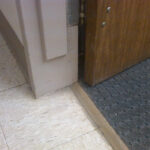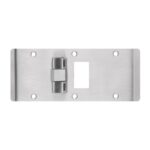As most of you are aware, I feel strongly about the retrofit security devices that some schools are choosing to purchase instead of upgrading to code-compliant locking hardware. I know that many of you agree with me, but our opinion is not always popular with the school districts. At least one hardware supplier was called a bully when she tried to educate the school district on the code requirements and the available solutions.
A few weeks ago I wrote a post about Paul Timm’s new book on school security and safety, in which he describes some solutions for classroom locking. Today I read an article written by Paul, which was published in School Planning and Management. This article addresses all of the issues with retrofit security devices that I have raised:
- Egress code problems – more than one operation to release the latch, special knowledge or effort
- Accessibility code problems – mounted outside the allowable range (34″ to 48″ AFF), not operable without tight grasping, pinching, or twisting, some products are mounted in the 10″ area at the bottom of the door that is supposed to be flush (push side)
- Fire code problems – some products inhibit positive latching required for fire doors and are not listed for use on a fire door assembly
- Unauthorized lockdown – devices may be used by anyone to secure the classroom, and incidents of assault, vandalism, theft, and sexual assault are thousands of times more likely than an intruder situation
- Lack of access – most retrofit devices do not allow staff or first responder access from the outside
If you work with schools in any capacity, I highly recommend that you read Paul’s article and share it with any school districts that are considering the use of retrofit security devices. It’s extremely valuable to have this perspective from a recognized school security expert who is not affiliated with the sale of a product. As Paul mentions in his conclusion, “For those pursuing alternative solutions, it is important to consider that some schools have installed after-market devices only to find out that code violations require their removal. Buyer beware! Be sure to involve fire marshals, door hardware manufacturers and insurance providers before investing in aftermarket products. Remember, the formula of collaboration and consensus tends to produce the best solutions.”
~~~
In other school security news…
The BHMA Codes and Government Affairs Committee has submitted code change proposals for the 2018 editions of the International Building Code (IBC) and the International Fire Code (IFC). The IBC proposal would require classrooms to be lockable from within the classroom without opening the door. Both proposals require doors to be compliant with section 1010.1.9 which includes the egress and accessibility requirements, and the proposals also require the ability for access from outside the classroom using a credential.
Remember, this is only a proposal and the cycle for the 2018 codes is just beginning. This is the proposal for the IBC, which would affect new buildings and some renovations:
1010.1.4.4 Occupancy Group E classrooms. In Occupancy Group E, classroom doors shall be lockable from within the classroom without opening the classroom door. All the following conditions shall apply:
- The classroom door shall be unlockable and openable from within the classroom and shall comply with Section 1010.1.9.
- The classroom door shall be unlockable and openable from outside the classroom by the use of a key or other credential.
1010.1.4.4.1 Remote operation of locks. Remote operation of locks complying with 1010.1.4.4 shall be permitted.
~~~
I have not seen any updated information about the situation in Ohio’s South West Licking School District, where the barricade devices purchased by a community group are not currently being allowed by the fire marshal (you can read about that here). But the conflict between the desire to provide security and the need for life safety is playing out in many jurisdictions across the country, and each state seems to be taking a slightly different approach. This variation from state-to-state and sometimes even from one district to the next is causing confusion, and some of the local changes have a negative impact on safety.
Here are some examples:
- Kansas Active Shooter Variance – retrofit security devices allowed during lockdown as long as device is not permanently attached
- Louisiana Interpretive Memorandum 2013-01 – deadbolt with thumbturn can be used in addition to existing lock/latchset – one additional releasing operation is allowed
- Maryland Final Locking Memo – mortise lock with thumbturn is the ONLY approved device for classrooms
- Colorado 8 CCR 1507-30 – temporary measures allowed until 1/1/2018
In other states, such as New York, Florida, Ohio, New Jersey, and California, the requirements for classroom doors are in line with current code requirements, and some of them address the ability to lock the door from within the classroom. If your state has issued a directive on classroom locking, let me know and I will add it to the list.
~~~
One of the challenges to maintaining code-compliant egress is the popular ALICE training, which advises students and staff to barricade doors with furniture. It’s a pretty short hop from piling furniture to purchasing barricade devices, so some code officials are differentiating between devices that are permanently attached (AHJ: “not allowed because of code-compliance issues”) and not permanently attached (AHJ: “not my jurisdiction to address”). From the many discussions I’ve had with fire marshals, I do think it is up to them to address barricade devices. Would they address chained panic hardware on the main entrance? I hope so.
You need to login or register to bookmark/favorite this content.







The barricaded door swings out, not in.
To the person that wrote this article, please send me an e-mail and I will readily address your concerns concerning ALICE, State and Federal recommendations for Active Shooter response in schools involving barricading of doors during active killer events and terrorism. FYI, the school district in Alabama was not trained by anyone associated with ALICE. The ALICE folks did a press release this month stating they do NOT endorse any secondary locking devices. The SFMO here in Ohio has asked me to testify next month at a hearing as an expert for the State regarding these devices. I can tell you that I am against their use for the reasons you cite, as well as several others. I look forward to hearing from you.